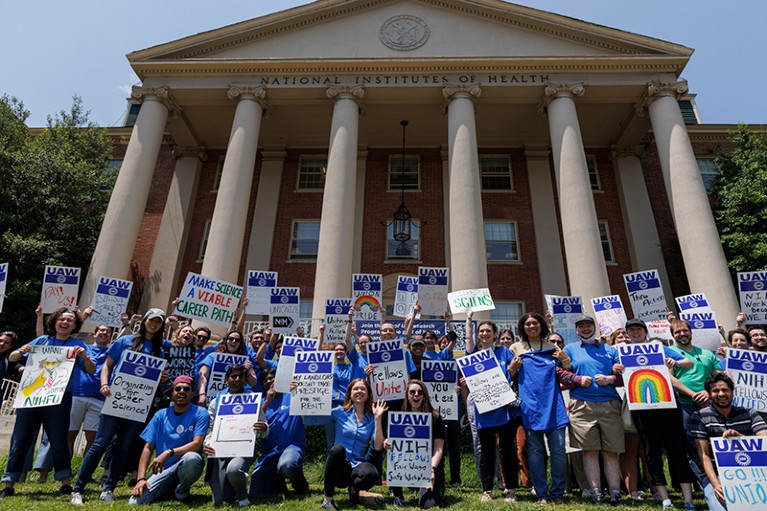Bethesda, Maryland
Thousands of early-career researchers at the US National Institutes of Health (NIH) have kick-started the process of forming a union. They are calling on the agency — the world’s largest biomedical funder — to raise pay and improve benefits, as well as to bolster its policies and procedures on harassment and excessive workloads.
About 150 of these researchers rallied on the NIH’s campus in Bethesda, Maryland, on 1 June to celebrate filing their union petition with the US Federal Labor Relations Authority (FLRA) in nearby Washington DC. The filing kicks off a months-long process that they hope will end in the union being officially recognized by the US government and the NIH.
“Doing science here at the NIH is fantastic,” Tara Fischer, a postdoc at the National Institute of Neurological Disorders and Stroke (NINDS), said at the rally, while holding an ‘NIH works because we do’ sign. “But it’s not so fantastic to be the people doing science here. We’re tired of waiting around for our working conditions to improve.”
The union, called NIH Fellows United, would include about 4,800 research fellows, such as graduate students and postdocs, who hold non-permanent staff positions at the agency’s 27 institutes and centres. That’s about one-tenth of the NIH’s workforce. (Some fellows are considered as federal contractors — not employees — and are excluded from workforce calculations.) So far, about 3,000 fellows have signed paperwork signalling their support for the union, according to organizers.
Amanda Fine, a spokesperson for the NIH, affirms the researchers’ right to organize and to join a union to advance their interests. “NIH will not interfere with any labour activity by the NIH Fellows United and will abide by any applicable laws and regulations,” she says.
Before the union can become official, the FLRA will need to certify the petition, and the fellows must hold an election in which a majority of eligible researchers agree to be represented by the union. If certified, it would be the first union to represent researchers at the NIH, the first for research fellows in the federal government and the largest federal union to form in around 12 years.
A workforce movement
The mobilization at the NIH comes amid a wave of academic workers forming unions across the United States, citing pay and working conditions that have failed to keep up with the rising cost of living. “These are issues that science needs to come to grips with,” says Rick McGee, associate dean of professional development at the Northwestern University Feinberg School of Medicine in Chicago, Illinois.

About 150 researchers rallied on NIH’s main campus on 1 June to celebrate filing their union petition.Credit: Melissa Lyttle for Nature
In late 2022, researchers belonging to multiple unions organized the largest higher-education strike in US history across the campuses of the University of California system. Research ground to a halt for six weeks after 48,000 academic staff stopped working and called for increased pay and better working conditions.
If certified as a union, NIH Fellows United could not walk off the job in a similar fashion, however: federal workers are not permitted to strike. Instead, the union would use other bargaining tactics, such as demonstrations, to push for improvements.
A better living
Once the union is certified, organizers would poll research fellows to determine what issues it should focus on, but higher wages are sure to be on the agenda.
The stipends currently being paid to fellows vary according to institute, experience and seniority, but some are below the annualized living wage of around US$45,000 in the Washington DC area. That living wage is “about $10,000 more than I’ve made in my time at the NIH”, says Margo Williams, a research fellow at the National Heart, Lung, and Blood Institute who plans to attend medical school later this year. “I haven’t been able to save, and it’s been difficult to plan financially for the future.” Fine responds that the NIH has recently changed its stipend structure, and that fellows receive benefits such as tuition reimbursement, health insurance, paid leave and career advice.
Because many research fellows are not considered employees of the NIH, but contractors, they are not eligible for benefits such as an employer-sponsored retirement plans. Some would also like this to change. “We’re here at the NIH for five years in our prime, ‘starting to save for retirement’ years, and we can’t do it,” says Marjorie Levinstein, a neuropharmacologist and postdoc at the National Institute on Drug Abuse. She adds that she is able to sustain her research career only because she is married to a partner who can supplement her income. Fine responds that retirement programmes cannot be offered to fellows who are considered contractors because of federal law.
If the NIH were to increase pay for its fellows, it might have ripple effects across the country, says Jonathan Wiest, former director of the Center for Cancer Training at the National Cancer Institute. That’s because the NIH also awards training grants to early-career researchers at universities across the country. Although NIH wages aren’t inherently tied to those training grants, if wages increased significantly for NIH fellows, universities might “raise holy hell”, Wiest says, because it could incentivize researchers to apply for NIH positions instead of those at universities.
Some established scientists commend the NIH’s fellows for taking the initiative to unionize. David Talmage, a neuroscientist at the NINDS, says that it’s time to “reconsider how we’ve been thinking about training. The system was set up when three-year postdocs would immediately lead to permanent positions in academia”, he says. “That doesn’t exist any more, and we’re losing a lot of incredibly smart people.”


Spread the word